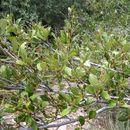en
names in breadcrumbs


Cercocarpus, commonly known as mountain mahogany, is a small genus of at least nine species of nitrogen-fixing[2] flowering plants in the rose family, Rosaceae. They are native to the western United States and northern Mexico, where they grow in chaparral and semidesert habitats and climates, often at high altitudes. Several are found in the California chaparral and woodlands ecoregion.
The classification of Cercocarpus within the Rosaceae has been unclear.[3][4] The genus has been placed in the subfamily Rosoideae, but is now placed in subfamily Dryadoideae.[5]
Members of the genus are deciduous shrubs or small trees, typically reaching heights of 3–6 m (9–18 ft) tall, but exceptionally up to 13 m (40 ft) high. C. montanus usually remains under 1 m (3 ft) high because of incessant browsing by elk and deer.
The name is derived from the Greek words κέρκος (kerkos), meaning "tail" and καρπός (karpos), meaning "fruit". It refers to the tail-like plume on the fruits.[6]
Cercocarpus comprises the following species:[7][8][9][10][11]
The status of the following species and hybrids is unresolved:[7]
Cercocarpus, commonly known as mountain mahogany, is a small genus of at least nine species of nitrogen-fixing flowering plants in the rose family, Rosaceae. They are native to the western United States and northern Mexico, where they grow in chaparral and semidesert habitats and climates, often at high altitudes. Several are found in the California chaparral and woodlands ecoregion.
 Cercocarpus intricatus, Spring Mountains, southern Nevada (elevation about 2700 m)
Cercocarpus intricatus, Spring Mountains, southern Nevada (elevation about 2700 m) The classification of Cercocarpus within the Rosaceae has been unclear. The genus has been placed in the subfamily Rosoideae, but is now placed in subfamily Dryadoideae.
Members of the genus are deciduous shrubs or small trees, typically reaching heights of 3–6 m (9–18 ft) tall, but exceptionally up to 13 m (40 ft) high. C. montanus usually remains under 1 m (3 ft) high because of incessant browsing by elk and deer.
The name is derived from the Greek words κέρκος (kerkos), meaning "tail" and καρπός (karpos), meaning "fruit". It refers to the tail-like plume on the fruits.